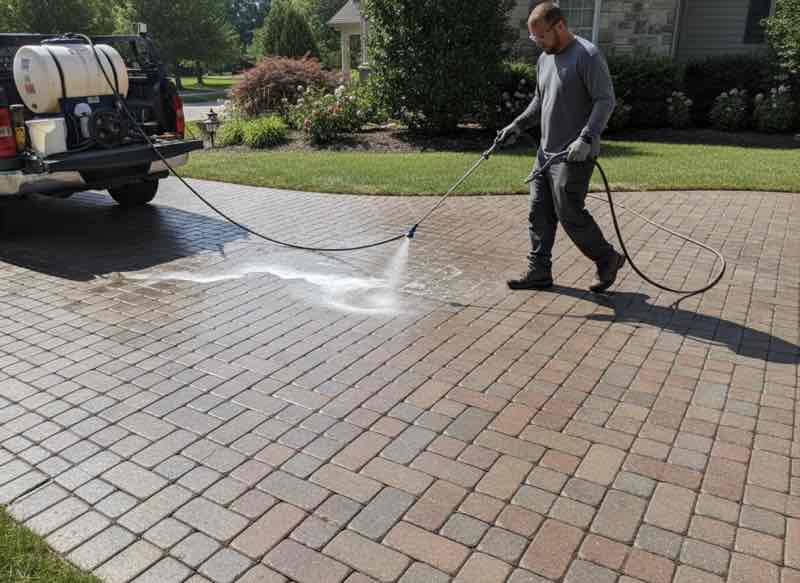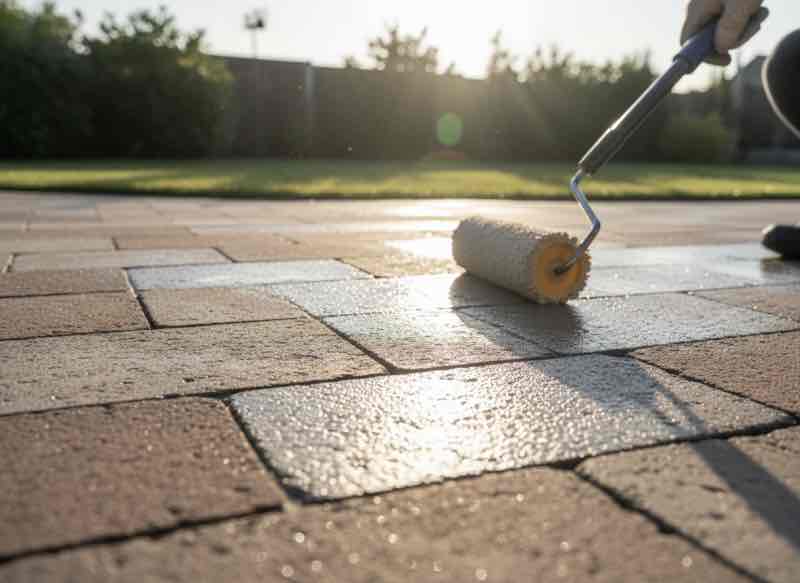When Should You Seal Pavers in Orlando?

Sealing pavers at the wrong time traps moisture under the surface. This creates a cloudy finish. You then pay hundreds of dollars to remove it and start over. Many homeowners seal too soon after installation. Others pick the wrong weather. A protective treatment becomes an expensive mistake.
This guide explains when you should seal pavers. We cover installation timing, temperature needs, and Central Florida weather. You learn the waiting period after new pavers go in. You learn the temperature range for proper drying. You learn which seasons work best in Orlando.
We explain how long to wait after installation. We show what temperature lets sealing work. We list which seasons give reliable weather. We cover the forecast needs that stop sealer problems. We give you a checklist. It tells you if your pavers are ready today or need more time.
When should you seal pavers after installation?
You should seal pavers 60 to 90 days after installation. This waiting time lets white salt marks come up and wash away. These white marks are called efflorescence. They show up as new pavers dry out and release moisture.
Sealing too soon traps these salts and moisture under the sealer. This causes cloudy spots and poor sticking. The sealer fails early. You must remove it completely and do it again.
Your pavers are ready to seal when:
- At least 60 days have passed since installation
- No white marks or salt spots show on the surface
- Daytime temperature stays between 50 and 90°F
- No rain shows in the forecast for 24 to 48 hours
- The paver surface is completely dry
Not sure if your pavers are ready? Get a free check and timing advice for professional paver sealing in Orlando.
How Long Should You Wait to Seal Pavers After Installation?

New pavers need 60 to 90 days before sealing. This waiting time lets the drying process finish. It lets white salt marks come up naturally.
These white marks are salt deposits. They rise to the surface as pavers release moisture. The salts come from the concrete, sand, and water used during installation. Rain and sun help draw these deposits up. You can brush them away or wash them off.
Sealing before these marks fully come up traps salts and moisture under the sealer. The trapped deposits cause a cloudy look. You cannot fix this without removing all the sealer. Early sealing also stops proper sticking. The sealer peels and flakes within the first year.
Check your pavers for these signs they are ready:
- No white haze or chalky film on the surface
- Pavers have been through several rain storms
- The surface looks the same color with no wet spots
- Sand between pavers has settled and stays in place
Some makers seal pavers at the factory. Check your paperwork to see if your pavers came pre-sealed. Pre-sealed pavers do not need more sealing right after installation.
On new paver jobs in Longwood, we set sealing appointments 90 days out. We do a check first to make sure white marks have cleared completely.
What Temperature Should It Be to Seal Pavers?
Paver sealer needs temperatures between 50 and 90°F to work right. Air temperature and surface temperature both matter. They affect how the sealer sticks and dries.
Temperatures below 50°F stop sealer from drying correctly. The chemical process slows down or stops. This leaves a sticky surface that picks up dirt. The sealer may never fully harden. You must remove it and try again when it warms up.
Temperatures above 90°F make sealer dry too fast. Quick drying creates marks where each pass overlaps. It makes an uneven finish. It stops proper soaking into the paver surface. The quick drying also shortens how long the sealer lasts.
Surface temperature matters more than air temperature. Dark pavers in direct Central Florida sun can hit 110°F. This happens even when air temperature reads 85°F. An infrared thermometer gives accurate surface readings before you start.
Orlando gets very hot from May through September. Morning work between 7 AM and 10 AM works best during these months. Evening work after 5 PM gives another option when surface temps drop below 90°F.
Different sealer types need specific temperatures:
We check surface temperature with an infrared thermometer during the whole job. We stop work if pavers go over 95°F. Rushed summer jobs that ignore temperature limits usually fail within the first year.
Skip the guessing and weather risk. See what professional paver sealing costs in Orlando. Get your recommended timing based on current conditions.
Best Time of Year to Seal Pavers in Central Florida

Spring and fall give the most reliable weather for sealing pavers in Orlando. March through May and October through November offer good temperatures. They have lower humidity and fewer daily rain storms.
Spring sealing from March to May uses comfortable temperatures before summer heat arrives. Morning dew dries quickly. Afternoon thunderstorms stay rare. This season works well for pavers installed last fall or winter. They have finished their drying time.
Fall sealing from October to November ranks as the second best window. October is not too late to seal pavers in Florida. Temperatures cool into the best 50 to 90°F range. Humidity drops. The daily afternoon storm pattern ends. Fall sealing protects pavers before holiday guests arrive. It sets them up well for winter use.
Summer sealing from June to September brings challenges. Daily afternoon thunderstorms and temperatures over 95°F require early morning work. You need flexibility to reschedule. This matters when weather forecasts show rain within 24 to 48 hours. Hurricane season from June through November adds another timing concern when active storms threaten Central Florida.
Winter sealing from December to February works in Florida. Northern states have freezing temperatures that stop winter work. Cold snaps sometimes drop Longwood temperatures below 50°F overnight. Daytime temps usually stay in the good range. Check weather forecasts for any cold fronts before scheduling winter sealing.
Central Florida's rainy season from June through September brings regular afternoon storms. This pattern makes morning work necessary. It also requires watching radar throughout the day. A sudden storm 12 hours after work can wash away sealer that has not dried. This forces you to do the whole job again.
Weather Conditions That Determine Sealing Success
Paver sealer needs 24 to 48 hours of dry weather after you apply it. Rain during this time washes away the sealer. It creates cloudy spots. It forces you to do the whole job again at full cost.
Check the hourly forecast before scheduling sealing work. A 20 percent chance of rain still poses risk during drying time. Reschedule when any rain shows in the 48 hour forecast window.
Rain that falls on sealer that has not dried causes several types of damage. Water drops create white spots or rings where sealer washes away. Heavy rain strips entire sections down to bare pavers. The leftover sealer dries unevenly. It requires professional removal before trying again.
Humidity above 90 percent slows the drying process even without rain. High humidity makes sealer take longer to fully harden. Orlando's summer humidity often stays above 90 percent overnight. This delays complete drying by several hours.
Wind affects sealing quality when speeds go over 10 to 15 miles per hour. Strong wind causes fast drying. This stops proper soaking in. It also blows dust and debris onto wet sealer. This creates a gritty finish that dulls the protective coating.
Morning dew interferes with sealer sticking. It settles on paver surfaces overnight. Wait for dew to dry completely before starting work. Pavers must feel dry to the touch. No moisture should be in joints or low spots.
Your weather window checklist before sealing:
- Clear skies for 24 to 48 hours after planned work
- Temperatures between 50 and 90°F throughout drying time
- Humidity below 90 percent when possible
- Wind speeds under 15 miles per hour
- No morning dew left on paver surface
- No recent rain in previous 24 hours
We have rescheduled jobs 15 minutes before start time. Morning dew had not burned off completely. That surface moisture ruins the sealer bond. It guarantees problems within months.
Signs Your Pavers Are Ready for Sealing (Checklist)
Your pavers show specific signs when they are ready for sealing. These visual and physical signs help you decide. You can proceed now or wait for better conditions.
Visual inspection shows surface readiness. Look for any white haze or chalky film. This indicates salt marks still coming up. Check joints between pavers for standing water. Check for damp sand that suggests drainage problems. Scan for recent stains from oil, rust, or organic matter. These need cleaning before sealing.
The touch test gives immediate feedback about moisture levels. Press your palm against several pavers in different areas. The surface should feel dry and slightly warm. It should not feel cool or damp. Cool pavers indicate moisture beneath the surface. This will cause sealer failure.
Age verification confirms the minimum waiting time has passed. Count 60 days from installation as the absolute minimum. 90 days is better for complete drying. New pavers sealed before 60 days almost always have problems within the first year.
Weather forecast review determines if conditions support good sealing. Check for clear skies going 48 hours past your planned work time. Verify temperatures will stay between 50 and 90°F throughout drying time. Confirm no cold fronts or storm systems are coming to Central Florida.
Professional assessment catches issues homeowners often miss. Experienced contractors spot bad drainage that causes water pooling. They find incomplete joint sand that needs more. They see existing damage that needs repair before sealing. A trained eye also spots salt marks in early stages. These are difficult for homeowners to see.
Getting the timing wrong costs $0.40 to $0.75 per square foot. This pays to strip failed sealer and apply it correctly. A 500 square foot driveway means $200 to $375 in removal costs. Then you pay again for proper sealing.
Complete ready-to-seal checklist:
- ☐ Minimum 60 days since installation (90 days better)
- ☐ No white haze or salt deposits visible
- ☐ Pavers feel dry and warm to touch
- ☐ Joint sand is settled and stable
- ☐ No standing water or damp spots
- ☐ Recent stains cleaned and dried
- ☐ Clear weather forecast for 48 hours
- ☐ Temperatures between 50-90°F predicted
- ☐ No morning dew or recent rain
- ☐ Surface repairs completed if needed
Conclusion
Sealing pavers at the right time protects your investment. It ensures years of strength. Wait 60 to 90 days after installation. This lets salt marks clear. Schedule work when temperatures stay between 50 and 90°F. Check forecasts show 48 hours of dry weather ahead.
Spring and fall offer the most reliable conditions in Central Florida. October through November gives excellent timing before the holiday season. March through May works well as temperatures warm. Summer work succeeds with early morning scheduling. Winter remains possible in Florida's mild climate.
Check your pavers against the readiness checklist before proceeding. Look for dry surfaces with no white haze. Verify the installation age. Confirm good weather windows. Professional assessment catches drainage issues. It catches incomplete drying that leads to sealer failure.
Protect your pavers at the perfect time. Get your free quote and recommended scheduling window for paver sealing in Longwood. We base timing on your installation date and current weather patterns.
